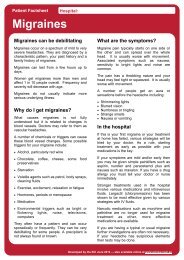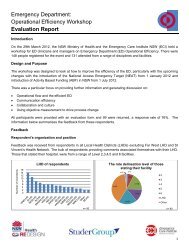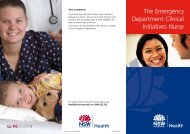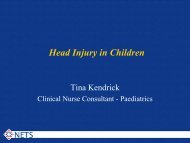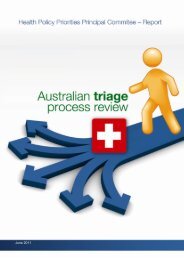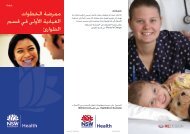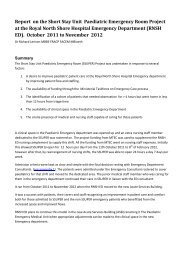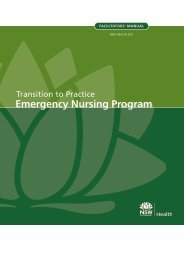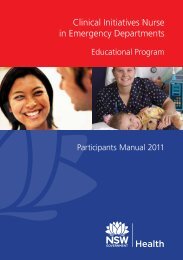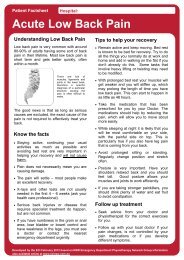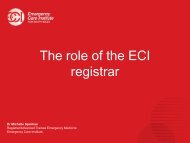Emergency Department Models of Care 2012 - NSW Health
Emergency Department Models of Care 2012 - NSW Health
Emergency Department Models of Care 2012 - NSW Health
- No tags were found...
Create successful ePaper yourself
Turn your PDF publications into a flip-book with our unique Google optimized e-Paper software.
challenges, the key aspects <strong>of</strong> what is needed to implementthe model and the measures to assess the model’seffectiveness.Other model <strong>of</strong> care considerationsPaediatric emergency patientsThe Model <strong>of</strong> <strong>Care</strong> document is applicable to bothpaediatric and adult emergency patients. The principles andother information included in each model can be applied tothe care <strong>of</strong> the paediatric patient.For the majority <strong>of</strong> EDs, catering to a mix <strong>of</strong> paediatric andadult patients, the unique needs <strong>of</strong> paediatric patients andtheir families must be considered. The factors forconsideration in model selection and implementation are:1. The physical space and geographical layout <strong>of</strong> the ED.This will influence the care <strong>of</strong> paediatric patients in thedifferent models <strong>of</strong> care.In EDs with a separate and designated paediatric area,streaming to that area may be all that is required. Forother EDs, local guidelines will determine theapplicability <strong>of</strong> the model for paediatric patients andwhether they will be assessed and treated in an areathat also treats adult patients. For example, paediatricpatients streamed to a mixed Fast Track model forassessment and treatment.In considering the model for both paediatric and adultpatients, it is important to consider the emotional needs<strong>of</strong> a sick or injured child, and that they should beprotected from stressful situations in ED and wherepossible, exposure to adult patients.2. The skills and level <strong>of</strong> experience <strong>of</strong> staff in caring forpaediatric patients. In an ED it is necessary to have staffwith appropriate training and experience in theemergency management <strong>of</strong> children and adolescents –this includes medical and nursing staff. The skill level <strong>of</strong>staff is an essential component <strong>of</strong> any model <strong>of</strong> carethat caters to children and needs to be well thought-outwhen planning and implementing a model <strong>of</strong> care.The Australasian College for <strong>Emergency</strong> Medicine policy onHospital <strong>Emergency</strong> <strong>Department</strong> Services for Children canbe found at: http://www.acem.org.au/media/P11_Hosp_ED_Services_for_Children_-ACP-ACEM.pdf. The RoyalAustralasian College <strong>of</strong> Physicians also has guidelines onstandards for the care <strong>of</strong> children and adolescents in healthservices. 88 National Standards for the <strong>Care</strong> <strong>of</strong> Children and Adolescents in <strong>Health</strong> ServicesRACP, 2008: http://www.racp.edu.au/index.cfm?objectid=393E4ADA-CDAA-D1AFStaffing the ED <strong>Models</strong> <strong>of</strong> <strong>Care</strong>Operating multiple models <strong>of</strong> care in an ED requires goodgovernance and coordination, and sufficient numbers <strong>of</strong>appropriately skilled staff to operate each model. A lack <strong>of</strong>appropriately skilled staff can lead to failure <strong>of</strong> the modeland suboptimal clinical outcomes for the patient. Forsuccessful operation and staffing <strong>of</strong> multiple models, severalfactors need consideration.Clinical Leadership. To effectively staff multiple models <strong>of</strong>care in an <strong>Emergency</strong> <strong>Department</strong> requires clinicalleadership for effective governance, operation and safedelivery <strong>of</strong> care for patients. The ED medical and nursingleaders are responsible for the effective communication andcoordination <strong>of</strong> care across all ED models in place. Withmultiple models, it is essential that there is a wellcoordinated approach to delivery <strong>of</strong> care to avoid any onemodel operating effectively at the expense <strong>of</strong> other areas <strong>of</strong>ED, and to prevent models operating in isolation.Clinical Expertise. The models <strong>of</strong> care in this documentprovide guidance to the skill mix <strong>of</strong> staff required for eachmodel. To effectively operate multiple models in your ED,the staffing levels and skill mix requirements should bedetermined based upon analysis <strong>of</strong> activity data and thevolume <strong>of</strong> patients who will be treated.The skill mix and expertise <strong>of</strong> staff needs to match therequirements <strong>of</strong> each model to deliver care – providing theright skills in the right place to make the rightdecisions. There is recognition <strong>of</strong> the specialist emergencynursing skills available, such as the Nurse Practitioner,Clinical Initiatives Nurse, Advanced Clinical Nurse and theFirst Line <strong>Emergency</strong> <strong>Care</strong> (FLEC) trained nursing staff.This document also recognises the importance <strong>of</strong> theavailability <strong>of</strong> senior medical clinical skills for optimaldecision making and resource allocation at the earliest pointin the patient’s journey, supervision <strong>of</strong> ED clinical caredelivery, and the important additional roles <strong>of</strong> specialistsenior medical staff in supervision and training <strong>of</strong> juniorclinical staff.In providing clinical expertise in each model appropriatetraining and education <strong>of</strong> staff is essential and this requiresongoing and updated training as required. Establishing andmaintaining the skills and expertise <strong>of</strong> staff is critical toproviding safe and quality emergency care.PAGE 10 <strong>NSW</strong> HEALTH <strong>Models</strong> <strong>of</strong> <strong>Emergency</strong> <strong>Care</strong>




